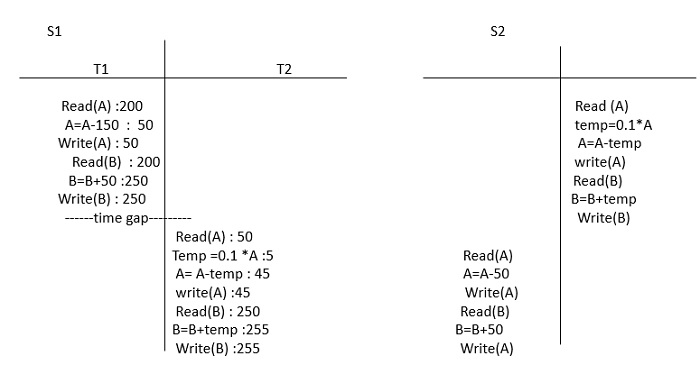
 Data Structure
Data Structure Networking
Networking RDBMS
RDBMS Operating System
Operating System Java
Java MS Excel
MS Excel iOS
iOS HTML
HTML CSS
CSS Android
Android Python
Python C Programming
C Programming C++
C++ C#
C# MongoDB
MongoDB MySQL
MySQL Javascript
Javascript PHP
PHP
- Selected Reading
- UPSC IAS Exams Notes
- Developer's Best Practices
- Questions and Answers
- Effective Resume Writing
- HR Interview Questions
- Computer Glossary
- Who is Who
Explain serial execution or transaction with an example(DBMS)
There are three possible ways in which a transaction can be executed. These are as follows −
Serial execution − In serial execution, the second transaction can begin its execution only after the first transaction has completed. This is possible on a uniprocessor system.
Parallel execution − In parallel execution, two transactions can start their execution at exactly the same instant of time. For this, we require more than one processor.
Concurrent execution − In concurrent execution, execution of the second process can begin even before the process has completed its execution.
Let us consider two transactions T1 and T2. In concurrent execution, the CPU executes some instructions of transaction T1, then moves to the second transaction and executes its instructions for some time and again it comes back to the first transaction.
The cycle is repeated until all the instructions of both the transactions are executed. The process is called context switching.
Example
Given below is an example of serial execution −
Let us consider two transactions T1 and T2 where T1 performs transfer Rs.150 from account A to account B and similarly T2 transfers 10% of balance from A to B.
T1 T2 Read(A) Read(A) A=A-150 temp =0.1 *A Write(A) A=A-temp Read(B) Write(A) B=B+150 Read(B) Write(B) B=B+temp Write(B)
The order in which the instructions of transaction T1 and T2 are executed is called a Schedule.
The possible serial schedules are as follows −
Let A= 200, B=200

Schedule S1 and S2 keeps the database in consistent state.
In general if the system consists of n number of transactions, then we can generate n! number of valid serial schedules.

